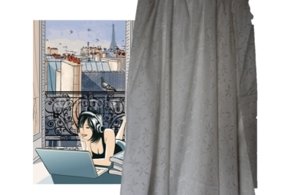
Karl Mayer showcases innovative systems at ITM
The cooperation between the two companies led to the development of a lightweight dense fabric with a pattern produced using a burnout technique.

12th January 2015
Knitting Industry
|
Obertshausen
This dense fabric, with its decorative, negative/positive design, was developed at Karl Mayer, on an HKS 4 machine. This high-speed tricot machine processed polyester to produce a lightweight fabric with a dense surface.
The pattern was then produced using a burnout technique by Blanke textech. The cooperation between these two companies led to the development of a net curtain which, compared to weaving, can be produced extremely efficiently and also looks attractive.
Based in Bad Salzuflen, the company produces high-end burnout net curtains using the rotary printing method for producing textile interior furnishings and can cater for rooms having a maximum height of 3 m.
Blanke textech successfully carried out research and development work over a period of several years, with a view to extending its processing technology from natural to synthetic fibres. In 2007, the company was able to present its first PES/PES burnout product that met the European standard, as well as all environmental regulations.
The new product, known as POLYOPAL, was exhibited at Heimtextil 2008 in Frankfurt and was nominated for an award presented by the well-known European architecture magazine, AIT.
So far, Blanke textech is said to be the only company in Europe operating the newly developed burnout process, which requires modified burnout fibres, as well as a special printing paste, and relevant production logistics set up.
Blanke textech can now produce burnout woven PES/PES fabrics, woven PES/CS fabrics and more recently, Karl Mayer’s PES/PES warp-knitted fabrics.
The burnout fabrics can be used for home and contract textiles, as well as for technical textiles, such as building materials, protective clothing and automotive products.

Business intelligence for the fibre, textiles and apparel industries: technologies, innovations, markets, investments, trade policy, sourcing, strategy...
Find out more